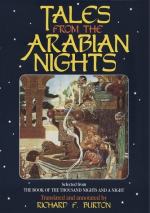[FN#17] Also from Al-Kazwini: it is an exaggerated description of the whale still common off the East African Coast. My crew was dreadfully frightened by one between Berberah and Aden. Nearchus scared away the whales in the Persian Gulf by trumpets (Strabo, lib. xv.). The owl-faced fish is unknown to me: it may perhaps be a seal or a manatee. Hole says that Father Martini, the Jesuit (seventeenth century), placed in the Canton Seas, an “animal with the head of a bird and the tail of a fish,” a parrot-beak?
[FN#18] The captain or master (not owner) of a ship.
[FN#19] The kindly Moslem feeling, shown to a namesake, however humble.
[FN#20] A popular phrase to express utter desolation.
[FN#21] The literature of all peoples contains this physiological perversion. Birds do not sing hymns; the song of the male is simply to call the female and when the pairing-season ends all are dumb.
[FN#22] The older “roc.” The word is Persian, with many meanings, e.g. a cheek (Lalla “Rookh"); a “rook” (hero) at chess; a rhinoceros, etc. The fable world-wide of the wundervogel is, as usual, founded upon fact: man remembers and combines but does not create. The Egyptian Bennu (Ti-bennu=phoenix) may have been a reminiscence of gigantic pterodactyls and other winged monsters. From the Nile the legend fabled by these Oriental “putters out or five for one” overspread the world and gave birth to the Eorosh of the Zend, whence the Pers. “Simurgh” (=the “thirty-fowl-like"), the “Bar Yuchre” of the Rabbis, the “Garuda” of the Hindus; the “Anka” ("long-neck”) of the Arabs; the “Hathilinga bird,” of Buddhagosha’s Parables, which had the strength of five elephants; the “Kerkes” of the Turks; the “Gryps” of the Greeks; the Russian “Norka”; the sacred dragon of the Chinese; the Japanese “Pheng” and “Kirni”; the “wise and ancient Bird” which sits upon the ash-tree yggdrasil, and the dragons, griffins, basilisks, etc. of the Middle Ages. A second basis wanting only a superstructure of exaggeration (M. Polo’s Ruch had wing-feathers twelve paces long) would be the huge birds but lately killed out. Sindbad may allude to the AEpyornus of Madagascar, a gigantic ostrich whose egg contains 2.35 gallons. The late Herr Hildebrand discovered on the African coast, facing Madagascar, traces of another huge bird. Bochart (Hierozoicon ii. 854) notices the Avium Avis Ruch and taking the pulli was followed by lapidation on the part of the parent bird. A Persian illustration in Lane (iii. 90) shows the Rukh carrying off three elephants in beak and pounces with the proportions of a hawk and field mice: and the Rukh hawking at an elephant is a favourite Persian subject. It is possible that the “Twelve Knights of the Round Table” were the twelve Rukhs of Persian story. We need not go, with Faber, to the Cherubim which guarded the Paradise-gate. The curious reader will consult Dr. H. H. Wilson’s Essays, edited by my learned correspondent, Dr. Rost, Librarian of the India House (vol. i. pp. 192-3).




